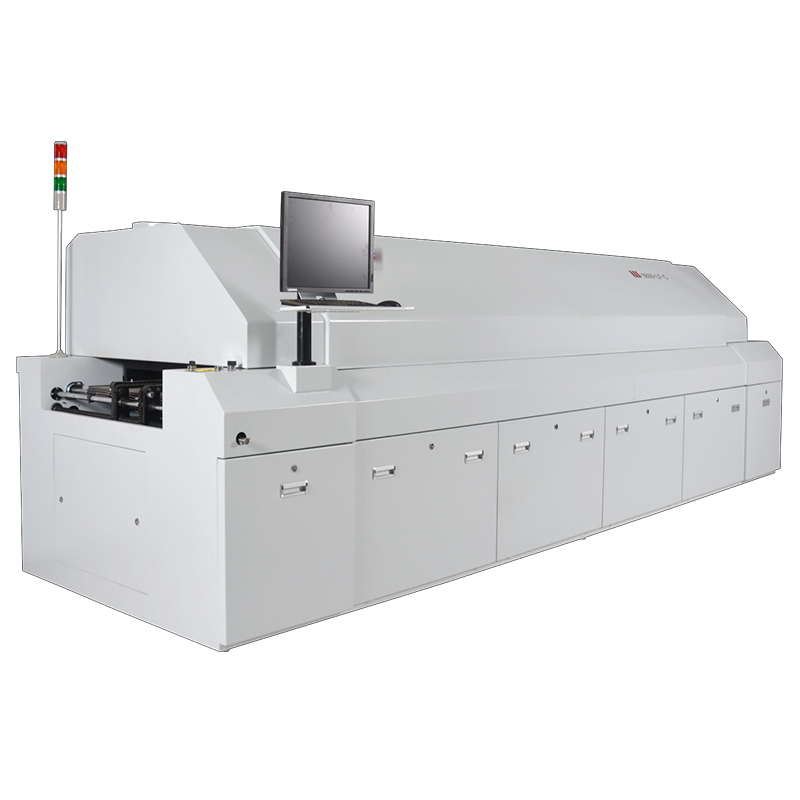Email format error
Email cannot be empty
Email already exists
6-20 characters(letters plus numbers only)
The password is inconsistent
Email format error
Email cannot be empty
Email does not exist
6-20 characters(letters plus numbers only)
The password is inconsistent


Understanding the Large Reflow Oven: A Comprehensive Guide
The large reflow oven is a critical piece of equipment in the world of electronics manufacturing. This comprehensive guide will delve into the importance, functionality, and various aspects of the large reflow oven, offering insights that will be beneficial whether you're an industry expert or a novice.
What is a Large Reflow Oven?
A large reflow oven is an industrial machine used primarily for soldering electronic components onto printed circuit boards (PCBs). The term "large" refers to the oven's capacity to handle high-volume production, making it essential for large-scale electronics manufacturing. This equipment is integral to achieving precise and reliable soldering, ensuring that the electronic devices function correctly.
The Working Principle of a Large Reflow Oven
Understanding the working principle of a large reflow oven is crucial for anyone involved in electronics manufacturing. The process generally involves several key stages:
1. Preheating
- Purpose: Gradually raises the temperature of the PCB and components to prevent thermal shock.
- Temperature Range: Typically between 150°C to 200°C.
- Duration: Varies depending on the PCB and components but generally lasts around 60 to 120 seconds.
2. Thermal Soak
- Purpose: Ensures uniform temperature distribution across the PCB.
- Temperature Range: 180°C to 200°C.
- Duration: Approximately 60 to 120 seconds to ensure all components reach a consistent temperature.
3. Reflow
- Purpose: Melts the solder paste to create reliable joints between components and the PCB.
- Temperature Range: Peaks at around 240°C to 250°C.
- Duration: Short, around 30 to 60 seconds, to prevent damage to the components.
4. Cooling
- Purpose: Solidifies the molten solder to secure the components in place.
- Cooling Rate: Controlled cooling to prevent thermal shock, generally around 4°C to 6°C per second.
Types of Large Reflow Ovens
Large reflow ovens come in various types, each designed to meet specific needs and manufacturing environments. Here are the most common types:
1. Convection Reflow Ovens
- Mechanism: Use heated air to transfer heat to the PCB and components.
- Advantages: Even heat distribution and precise temperature control.
- Applications: Widely used in the electronics industry for various types of PCBs.
2. Infrared Reflow Ovens
- Mechanism: Use infrared radiation to heat the PCB directly.
- Advantages: Efficient energy use and quick heating times.
- Applications: Suitable for specific types of components that absorb infrared energy well.
3. Vapour Phase Reflow Ovens
- Mechanism: Use vaporized liquid to transfer heat through condensation.
- Advantages: Highly uniform temperature and reduced risk of overheating.
- Applications: Ideal for complex or temperature-sensitive assemblies.
Benefits of Using a Large Reflow Oven
The advantages in electronics manufacturing are numerous. Here are some key benefits:
1. High Throughput
- Efficiency: Capable of handling large volumes of PCBs, making it ideal for mass production.
- Speed: Faster processing times compared to smaller ovens.
2. Precision and Consistency
- Temperature Control: Precise control over heating profiles ensures consistent soldering quality.
- Repeatability: Ensures the same high-quality results in every batch.
3. Versatility
- Component Compatibility: Suitable for a wide range of components, including lead-free and leaded components.
- Flexible Profiles: Can be adjusted to meet specific soldering requirements.
Key Features to Look for in a Large Reflow Oven
When selecting a large reflow oven, several features are essential to consider to ensure it meets your production needs:
1. Heating Zones
- Multiple Zones: Allows for precise control of different stages of the reflow process.
- Independent Control: Each zone can be individually controlled for optimal temperature profiles.
2. Conveyor System
- Belt Type: Should be durable and capable of handling various PCB sizes.
- Speed Control: Adjustable speed to match the production rate and specific process requirements.
3. Temperature Control and Monitoring
- Accuracy: High-precision sensors and controllers to maintain consistent temperatures.
- Monitoring: Real-time monitoring and data logging for quality control and troubleshooting.
4. Cooling System
- Effective Cooling: Ensures quick and controlled cooling to prevent thermal shock and ensure solder joint reliability.
- Adjustability: Ability to adjust the cooling rate to suit different types of PCBs and components.
Maintenance and Care for Large Reflow Ovens
Proper maintenance and care are crucial for ensuring the longevity and optimal performance of a large reflow oven. Here are some maintenance tips:
1. Regular Cleaning
- Prevent Residue Build-Up: Clean the oven regularly to prevent solder and flux residues from accumulating, which can affect performance.
- Use Appropriate Cleaners: Ensure that the cleaning agents are suitable for the materials and components of the oven.
2. Periodic Calibration
- Temperature Calibration: Regularly calibrate the temperature sensors and controllers to maintain accuracy.
- Conveyor Calibration: Ensure that the conveyor speed and alignment are correct to avoid production issues.
3. Inspection and Replacement
- Routine Inspections: Inspect critical components such as heating elements, sensors, and conveyor belts for wear and tear.
- Timely Replacements: Replace any worn or damaged parts promptly to avoid downtime and ensure consistent performance.
Choosing a Lead-Free Reflow Oven Supplier
In the context of modern electronics manufacturing, the shift towards lead-free soldering has become a significant trend. Choosing a reliable lead-free reflow oven supplier is crucial for ensuring that your manufacturing process complies with environmental regulations and quality standards.
1. Compliance with Standards
- RoHS Compliance: Ensure the supplier's ovens are compliant with the Restriction of Hazardous Substances (RoHS) directive.
- Quality Assurance: Look for suppliers that provide detailed documentation and certification of compliance.
2. Technological Advancements
- Innovative Designs: Choose suppliers that offer the latest technological advancements in lead-free soldering.
- Energy Efficiency: Opt for ovens designed to be energy-efficient, which can reduce operating costs and environmental impact.
3. Support and Service
- Technical Support: Reliable technical support is essential for troubleshooting and optimizing the reflow process.
- After-Sales Service: Ensure the supplier offers comprehensive after-sales service, including maintenance, repairs, and spare parts availability.
The Future of Large Reflow Ovens
As technology continues to evolve, the future looks promising. Several trends and advancements are expected to shape the industry:
1. Automation and Industry 4.0
- Smart Ovens: Integration with Industry 4.0 technologies will lead to smarter ovens with advanced monitoring, control, and predictive maintenance capabilities.
- Automation: Increased automation in reflow ovens will enhance productivity and reduce the need for manual intervention.
2. Energy Efficiency
- Eco-Friendly Designs: Future ovens will focus on reducing energy consumption and minimizing environmental impact.
- Regenerative Heating: Innovative heating methods that recycle heat energy to improve efficiency.
3. Advanced Materials
- New Solder Materials: The development of new solder materials compatible with large reflow ovens will enhance performance and reliability.
- Heat-Resistant Components: Improved materials for oven components that can withstand higher temperatures and longer operational hours.
Conclusion
The large reflow oven is an indispensable tool in the electronics manufacturing industry, offering high throughput, precision, and versatility. Understanding its working principles, types, benefits, and key features can help you make informed decisions for your production needs. Moreover, proper maintenance and selecting a reliable reflow oven supplier are critical for ensuring optimal performance and compliance with industry standards.
As technology advances, the future promises increased automation, energy efficiency, and innovative materials, paving the way for even more efficient and reliable electronics manufacturing processes. By staying informed and adapting to these changes, manufacturers can continue to produce high-quality electronic devices that meet the growing demands of the market.

